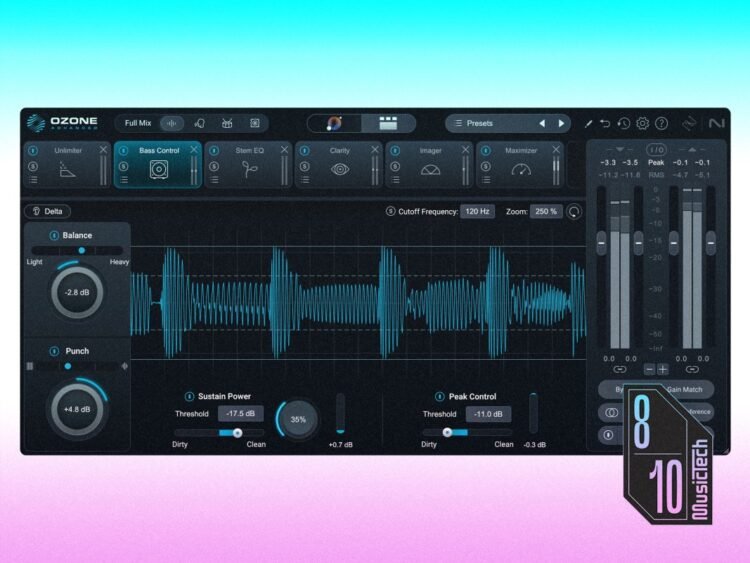Advanced £479 / Standard £209 / Elements £55, izotope.com
Over the last 20 years, iZotope Ozone has grown into one of the most capable all-in-one mastering solutions there is. The new 12th edition brings with it some rather novel new processors and further enhancements to the AI-driven features first seen in Ozone 8.
Is it now the undisputed master of mastering? Let’s find out.

What is iZotope Ozone?
As has become the norm for the product line, Ozone 12 provides a single ‘mothership’ plugin and, if using the Advanced edition that I’m working with here, a suite of individual module plugins.
The mothership plugin provides the means to host a full chain of Ozone’s mastering processors, along with additional tools useful in mastering, such as dithering, previewing the impact of MP3 encoding at different data rates, and the ability to compare with a reference track.
The individual module plugins are simply the individual Ozone processors packed into their own plugins. These function exactly as they do when loaded into the mothership’s mastering chain, but have the full freedom of your DAW’s routing system, allowing for chains that are more complex than the mothership’s simple serial arrangement. Also, despite being designed for mastering applications, many of the module plugins can be put to good use during tracking and mixing too, a fact that significantly adds to the value and utility of the package.

Can Ozone 12 master for me?
Ozone’s Master Assistant, part of the mothership plugin, is an AI-driven system that analyses a portion of a mix and then chooses the processors and settings that it considers most appropriate for mastering that mix. It also provides a simplified, intuitive interface through which you can tweak and adjust the settings without needing to delve into the details of the underlying processors. Those who do wish to delve can switch to the Detailed View, which provides full access to the processing chain and the processors within it.
Improvements in version 12 bring a new workflow to Master Assistant that allows the system to be pre-configured prior to analysing a mix – choosing the processors that the assistant is allowed to use, dialling in a target loudness, and specifying the musical genre. To support this, the Stabilizer processor now has a set of 25 genre targets, plus the ability to create custom targets by analysing a reference track. This newfound pre-configurability makes the Master Assistant far more controllable, saving a lot of time in the long run, but the option to leave all of these initial details to the assistant remains, as does the ability to modify and overrule the assistant’s decisions once they’re made.
Master Assistant’s results are normally acceptable but rarely perfect, but this is to be expected. iZotope stresses that Master Assistant is intended as a guide, not a decision maker; it takes care of the donkey work, but it is always expected that the user will adapt the Assistant’s configuration to their own tastes. Perhaps the best way to think of it is as an eager studio assistant, albeit one that can’t be sent to make the tea.
The other important AI-powered tool found in the mothership plugin is Stem Focus, which allows the processing chain to be targeted at a specific stem within the mix – vocal, drums or bass. First introduced in the previous version, Ozone 12 improves the accuracy of the stem separation and produces fewer sonic artefacts, but I’m disappointed that no new stem types have been added, not even an ‘other’ category.

What are the new processors in Ozone 12?
Proof that iZotope’s neural network technology can extract an ‘other’ stem in real time can be found in the new Stem EQ processor. This splits the mix into Vocal, Drums, Bass and Other stems, and allows a separate EQ curve of up to eight bands to be defined for each stem. This means you can, for example, add presence to a vocal, remove the harshness from cymbals, and/or fatten a bassline, all without impacting any other instruments within the mix. It’s an absolute game-changer for mastering engineers, enabling the sorts of corrections that would otherwise require a new mix to be produced or requested.
Another common problem that can render a mix unmasterable is heavy-handed use of mix compression and/or limiting, but Ozone 12 has a fix. Unlimiter restores transients and dynamics in over-compressed sources via an easy-to-configure interface.
Unlimiter works well when it’s largely the transients of a mix that have been crushed, and here it does an impressive job of restoring dynamic space and detail. But it’s less effective when dealing with a mix that’s more generally over-cooked, although it still improves transients. Combining Unlimiter with cunning use of multiple mothership instances and Stem Focus modes does provide more remedial options, but if you start needing to resort to such things, it’s probably a sign you need to request a new mix!
Moving on, we come to Bass Control – a remarkably versatile way of shaping, taming and/or enhancing the low end of a mix or stem. It can add or remove weight, add punch and/or smoothness, and generally pull the often-awkward bass frequencies into line. Also, with low frequencies tending to be the hardest to judge and balance, Bass Control’s visualisations prove useful in highlighting details that are extremely difficult to detect by ear.
The final all-new feature in Ozone 12 is a new IRC (Intelligent Release Control) mode for the Maximiser. Like the other modes, IRC 5 constantly analyses the incoming signal and uses psychoacoustic principles to shape the response of Maximiser’s limiter. But unlike the other modes, IRC 5 does this using a four-band multiband limiter. This results in a phenomenal ability to add loudness whilst retaining clarity and avoiding clipping, crushing, pumping and other undesirable artefacts. If you’re still engaging in the tiresome loudness wars, there’s little else that will deliver such high integrated LUFS values with such transparency.

Should I get Ozone 12, and which edition is best for me?
Ozone 12 comes in three editions: Elements, Standard and Advanced. Elements has its uses but doesn’t have much to offer to anyone seeking a comprehensive mastering solution. The affordable Standard edition, on the other hand, contains everything you need to add the final polish to your own tracks and mixes.
Although more than twice the price of Standard, Advanced is the only version that includes tools that can fix gnarly mix problems that would normally necessitate a new mix, principally Stem EQ, Unlimiter and Stem Focus. As such, it’s a no-brainer for those who master other people’s music. Advanced is also the only edition that includes the individual module plugins. These do add value in their own right, but it’s a bit tight to make them exclusive to the Advanced edition – it’s not like it would cost iZotope anything to supply the individual module plugins with the Standard edition.
That aside, there’s no question that Ozone 12’s powerful, often innovative, processors and assistive AI technology that never interferes can deliver masterful masters, whether you’re new to mastering or an experienced engineer with credits under your belt.

Key features
- Up to 20 mastering processors with AI-assisted configuration
- Compatible with macOS Ventura+ and Windows 10+
AAX, AU and VST3 - Mothership plugin hosts processor chain and other mastering tools
- Ozone modules also come as individual module plugins (Advanced only)
- Improved Master Assistant
- Improved Stem Focus algorithm
- NEW IRC 5 Maximiser mode
- NEW Stem EQ (Advanced only)
- NEW Bass Control (Advanced only)
- New Unlimiter (Advanced only)
Get the MusicTech newsletter
Get the latest news, reviews and tutorials to your inbox.






